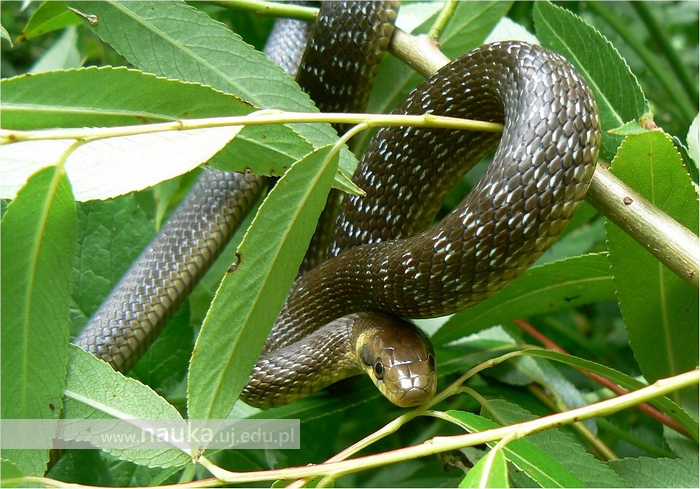
Can we aid a snake in survival? Sure we can! And we should, even more so when it comes to a critically endangered species and the rarest reptile in Poland.
Zamenis longissimus – which is the scientific name for the Aeasculapian snake – is a very good climber, able to get to the highest tree branches. It may sometimes enter houses or bus stops in search for a safe hiding spot. Its head possesses a characteristic "smiling" or "surprised" features. The snake can grow up to 1.7 metres, which makes it the longest reptile in Poland. Its size, coupled with its feeding habits, may scare us, as it tends to constrict its prey with considerable strength. However, we need not worry, as the Aesculapian snake prefers mice and lizards over humans.
The reptile can be found in the valley of the river San. Currently, there are about 200 specimens in the wild, which unfortunately earns the snake a place in the Polish Red Data Book of Animals (a book that lists endangered species in Poland). Natural scientists from the Polish Academy of Science Institute of Nature Conservation and herpetologists from the Jagiellonian University are coming to the creature's aid.
Make snakes feel at home
The main reason for such a low number of snakes is our country's climate. Because of varied weather conditions and autumn-winter chills, they have a problem with egg incubation. Stanisław Bury from the JU Institute of Environmental Sciences explained that the climate in southern Poland is suboptimal, which means it is a little less comfortable than the snakes would like it to be.
The females are not caring mothers, they leave their eggs after they lay them. Luckily, Aesculapian snakes do not require a particularly luxurious environment – a heap of sawdust, hay or tree branches will suffice. They provide shelter, a place to hibernate and optimal temperature for the snake's brood. Sawdust mounds have the advantage of facilitating the observation of the snakes for research purposes.
One of the actions taken to help the Aesculapian snake is a project funded by the State Forests National Forest Holding and the National Fund for Environmental Protection and Water Management. Thanks to the assistance provided by these institutions, and the knowledge and experience of Kraków biologists, there are more and more places in which the reptiles may lay their eggs.
The Truman Ssshow
 Scientists have studied the behaviour and habitat of the Aesculapian snake for many years. One of the more efficient ways to do it is telemetry, a system which tracks the movement and location of the animals and then sends them to the researchers.
Scientists have studied the behaviour and habitat of the Aesculapian snake for many years. One of the more efficient ways to do it is telemetry, a system which tracks the movement and location of the animals and then sends them to the researchers.
The snakes' mode of locomotion allows the tracking device to be put in three places: it can be implanted into the skin, inserted into the digestive system or simply stuck to the skin. The first of these methods is the most precise and effective, as there is no way for the animal to excrete or lose it. However, it is also the most invasive method – it requires anaesthetising the snake and can lead to infections or complications. Therefore, two other methods are used frequently despite their reduced effectiveness.
In the long run, telemetry results may be used to better understand the life cycle of the Aesculapian snake. We could say it is the snake version of The Truman Show, since the animal is unknowingly observed during its daily activities. Human curiosity knows no bounds.
Fork-tongued neighbours
Why does Zamenis longissimus like Western Bukovec Mountains so much? According to Stanisław Bury, after the Soviet-installed communist authorities initiated Operation Vistula (forced resettlement of the Ukrainian minority as well as Boykos and Lemkos in the years 1947–1950), the area surrounding Bukovec Mountains became depopulated. When people were forced out of their homes, snakes settled in the abandoned houses and barns. Several years later, people started moving back again. They were not frightened by the abundance of snakes; in fact, they saw them as harmless and useful for pest control.
Stanisław Bury thinks that the inhabitants of the region may be used to the sight of snakes due to cultural reasons (the Boykos are an ethnic group native to Bukovec Mountains). Old local legends spoke of a deity by the name of which who was believed to live in that area. It could assume the form of a snake. Later, a town was founded on its sacred site. The town, at first known as Ralskie, changed its name to Rajskie during the course of its history. Not surprisingly, Aesculapian snakes can be found in the area surrounding the town. We can then presume that these reptiles are a part of the local cultural heritage.
Researching Aesculapian snakes' life cycle and facilitating their reproduction will not increase the reptiles' population in a day, or even a year. But it is important to remember that only consistent, hard work will help preserve these animals. So if you see a long "smiling"olive-coloured snake slithering by, let it go about its business. Maybe it's going out on a date?
Original text: www.nauka.uj.edu.pl





